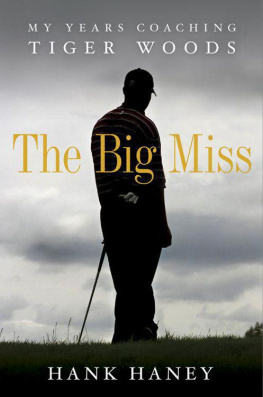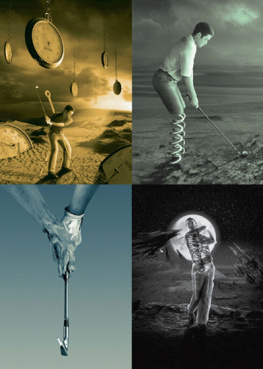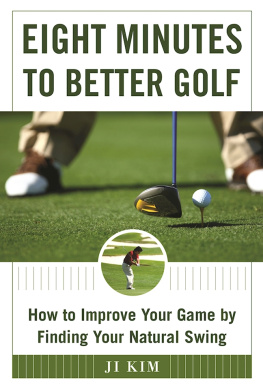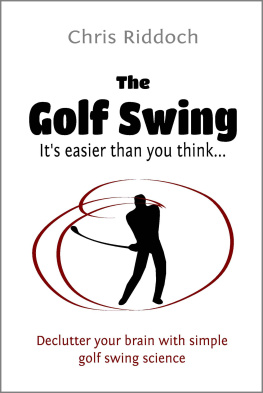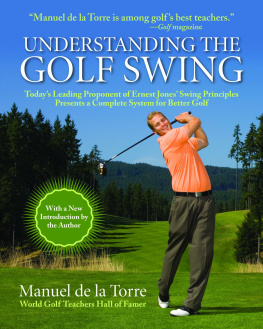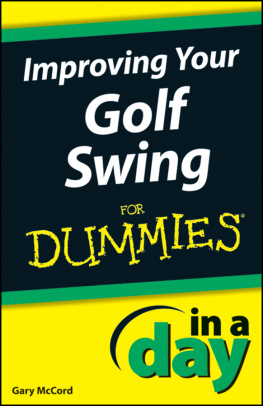The Only
Golf Lesson
Youll Ever
Need Easy Solutions to Problem Golf Swings
HANK HANEY
WITH J OHN H UGGAN

For my wife, Jerilynn, my biggest supporter.
Contents
Part One
Understanding Your Swing
Part Two
Fixing Your Swing
Part Three
Using Your Swing
It was the fall of 82. I was in my second year on the PGA Tour and I was struggling. In fact, it looked at that point like I might lose my tour card. I had no idea what I was doing wrong. Everyone told me I had a nice swing, but I had always wondered why, if that were the case, I didnt play better. And how come I felt so bad over some shots?
Dont get me wrong. I was a pretty good player at that point. Id won the U.S. Amateur championship, needed only one visit to the Q-school en route to the tour, and been rookie of the year in my first full season. But I was getting by on natural ability and nice rhythm. Which can be fine. Some days I played really well. But I was never consistent, especially under pressure. My philosophy was that if I hooked a shot I must have swung too fast. In other words, I was unbelievably naive when it came to understanding how my swing workedor didnt work.
Then fate took a hand.
I was on the practice range at the Pinehurst Hotel & Country Club when I bumped into a young instructor by the name of Hank Haney. Little did I know at the time that meeting Hank would be one of the most significant events in my career.
Before our first lesson I was like any other golferin need of a quick fix. Hank watched me hit balls for about thirty-five to forty minutes and never said a word. I kept waiting for him to tell me to move the ball forward or change my grip; the sort of things youd typically hear from any other instructor.
Eventually Hank asked me if I had thirty minutes to go sit down and talk about what I needed to do. I thought, Not really. Im about to lose my card. I need to keep pounding away here.
But he said, Nah, were not doing any good here. Lets go talk about what I think is the correct way to swing the golf club. On the way Ill point out the way you are swinging and why you are seeing the ball-flight youve got right now.
So we did that. Hank opened my eyes to the fact that I had some major flaws in my swing. If I wanted to be more consistent, we had some work to do.
Hank convinced me that if I worked on shallowing my swing plane and getting my arms and body working as one then my impact position would be better and my ball-flight would be better. Under the gun Id be better, too. Mental toughness can only take you so far. Over the last few holes of a tournament you need a technique you can count on.
I didnt get better right away. In fact, I got worse before I got better. Of course, its a constant battle to improve at this gameIm still trying to improve my techniquebut Hank told me there was no time frame.
So all of a sudden I was thinking of three or four things on the course. Id never done that before and my swing became more mechanical. So I struggled. But we worked and worked and eventually I got it.
In the last sixteen years Hank has watched me hit well over a million golf balls. There have been some trying moments but Im glad we both hung in there. The light at the end of my particular tunnel came on at the end of 83. I won my first event in 84 at Milwaukee and finished second on the money list.
Now, that had a lot to do with me, but I know it would have been difficult to achieve the success I have without the commitment and hard work Hank has put into my game. Im proud of the way my swing holds up in all kinds of conditions and under the severest pressure. Both are a tribute to Hank and his teaching. He knows more about ball-flight and what controls it than anyone in the game. And if you understand that, youre on your way.
What makes Hank different for me is how positive he is. He really believes in himself and his ability to make you a better golfer. And he was so willing to help me get better. Those are the things you look for in an instructor.
Indeed, thats what makes Hank such a great instructorhis willingness to help people. Hes always looking for ways to help you improve.
What hes told me can help everybody. In fact, Hank gets more enjoyment out of teaching high-handicappers than he does from working with a tour pro. He can fix anyone.
People have often asked me how to describe Hank Haney. To me, he is a man on a mission. Hes dedicated to being the best that he can be. Hes first-class all the way and he loves golf. That is the type of person I want around me.
Today, Hank is my best friend. He has been there for me more than anyone outside of my immediate family. Hes been a mentor of sorts, too. He has helped me with every aspect of my game, not just my full swing.
Hank also has the ability to laugh. We were practicing at Pinehurst one time. It was raining. The temperature was barely above freezing. And our session wasnt going well. I started with my sand wedge and that wasnt going right. So I threw it down the range. Then I went to my wedge. Same thing. And so on right through the bag. Eventually all I had left was my umbrella and my golf bag. All Hank said was, Well, we could work with the umbrella, but now might be a good time to take a little break.
We went in, had a drink, and came back out. Then we started over. Hank would stand there and watch me hit all day. Thats the sort of commitment he has to all of his pupils. Hes a special man and a great teacher.
Even today, twenty-odd tournament wins and two professional major championship victories later, there are still flaws in my swing. Hank and I know that. But were still working to get better. Now youve found him, too. Read on and improve.
M ARK OM EARA
J ULY 1998
Hi, Im Hank Haney. Thanks for coming to me for a golf lesson. Before I take a look at your swing and your shots, let me ask a few questions about you and your game.
How long have you played golf?
What is your handicap?
What is the lowest your handicap has ever been?
How often do you play?
How often do you practice?
Where does your ball go? Does it slice? Does it hook?
Where do most of your short-iron shots finish?
Do you tend to hit the ball fat or thin?
When you hit it fat, do you make a deep divot, or simply hit behind the ball?
Do you tend to hit the ball off the toe of the club, or the heel of the club?
Do your shots tend to start right of your target, or left of your target?
Do your shots tend to fly too high or too low?
Which shot gives you the most difficulty?
What is your favorite club?
What is your least favorite club?
If you had a tree in your way and could play either a slice or a hook around it, which would you choose?
Where do most of your bad drives finish?
That last one is especially important and reveals much about your swing. Your driver is your straightest-faced club, so shots hit with it are going to curve the most. The shape of your drives exposes your swing tendencies. That comes as a big shock to most people. It isnt because the driver is bigger. Or longer. Or heavier. Its because of the face. The lack of loft causes you to hit more in the middle of the ball, which means that if the face is open or closed, your shots will have substantial curve right or left. More loft produces more backspin on your ball, which counteracts any sidespin. Thats why it is relatively easy to hit a straight shot with your wedge.
Next page

